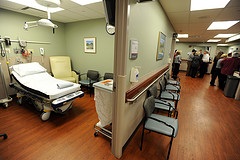Consumer Reports rates hospital safety: Where do we stand?

AnnArbor.com photo
If you're like me, the only time you ever want to be in a hospital is when you really need one. But when we do, we expect our treatment to make us well, not worse. After all, hospitals are supposed to be especially clean, they are full of medical professionals, and stocked with modern equipment and medicines.
However, even the best hospitals make errors that result in unnecessary harm to patients. And ratings recently published by Consumer Reports show that U.S. hospitals, including those in Ann Arbor, can do a much better job preventing those errors.
Estimates of deaths due to preventable medical mistakes range from 44,000 to over 200,000 annually. According to the U.S. Government Accountability Office, you are more likely to die from a medical mistake than from an auto accident, breast cancer or AIDS. And the Department of Health and Human Services estimated that of 1 million Medicare beneficiaries hospitalized in October 2008, about 13.5 percent (134,000) experienced an adverse event (harm to a patient) during their stay.
Consumer Reports recently evaluated hospital safety data and has released ratings for more than 1,000 hospitals, representing about 18 percent of all U.S. hospitals. Safety was scored on a 100-point scale, with each of the following categories contributing 20 points to the overall score.
- Avoidance of post-surgical infections, such as those from the use of central-line catheters or following major surgical procedures.
- The rate of patients suffering heart attacks, heart failure or pneumonia who needed to be readmitted within 30 days after initial discharge.
- How clearly hospital staff communicated discharge planning and use of medications to patients.
- Use of appropriate CAT scanning to avoid exposing patients to excess radiation.
- The rates of eight adverse complications and six causes of deaths in the hospital.
The overall results show lots of room for improvement, as the top-rated hospitals scored only in the low 70s, and no hospitals received top marks for readmission rate or communication.
How did Ann Arbor area hospitals rate in the study? Not as well as might be hoped.
- The University of Michigan Hospitals and Health Centers had a total score of 50, with average scores for avoiding post-surgical infections and clarity of communication, a high score for appropriate scanning, and a low score for readmission rate.
- St. Joseph Mercy Hospital in Ypsilanti had a total score of 60, with above average scores for infections and scanning, and below average scores for communication and readmission rate.
- The highest-scoring hospitals in the area were Bronson Methodist Hospital in Kalamazoo (64), and Allegiance Health in Jackson (63). Both scored high in avoiding post-surgical infections and performing appropriate scans.
- The highest-scoring hospital in Michigan was Northern Michigan Regional Hospital in Petoskey, with a total score of 69.
Veteran Affairs and children's hospitals weren't included in the ratings (the article explains why), so there is no information on the Ann Arbor VA Hospital or C.S. Mott.
Consumer Reports recommends several practices that patients and families can use to help reduce the risk of preventable medical errors. To reduce the risks of infections, for example, insist that caretakers always wash their hands before touching patients, and ask every day whether catheters or tubes can be removed. To reduce the odds of needing readmission after release, see a discharge planner and get a written summary of what you will need to do at home and when you can resume your normal activities.
The report is published in the August 2012 print edition of Consumer Reports magazine and online at ConsumerReports.org, including the list of hospitals and their ratings. To view the entire report and full list of hospitals requires a subscription, but summary information is available for non-subscribers.
Jeff Jackson is a runner, cyclist, and student of Aikido who writes the Fitness at 50 blog. His other interests include history, writing, and food. He can be reached at jeff@fitnessat50.net.


Comments
Jeremy Engdahl-Johnson
Tue, Jul 17, 2012 : 3:35 p.m.
Medical errors research in latest Health Affairs. Society of Actuaries study indicates more than 2 million patient injuries each year. http://www.healthcaretownhall.com/?p=3809
Jeff Jackson
Wed, Jul 18, 2012 : 2:52 a.m.
Yes, the estimates I've seen range from 400,000 to over 2 million people affected by medical mistakes per year. The problem is that there is no nationwide consistent standard or system for reporting medical mistakes, so a lot of them go unrecorded or aren't made available to the public. But even the conservative numbers are alarming enough. A couple of years ago I was the victim of a medical mistake. Fortunately, it was a records error and not a treatment error, but I was still unable to purchase life insurance for over a year until the erroneous record was found and corrected. Jeff